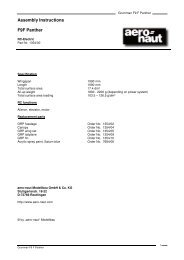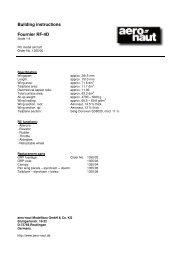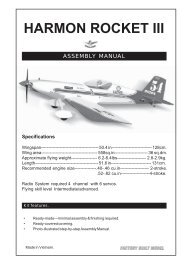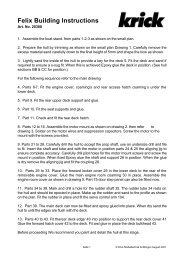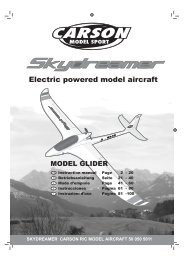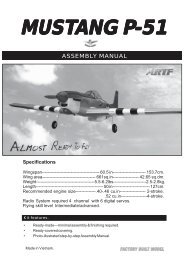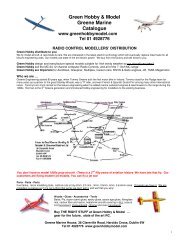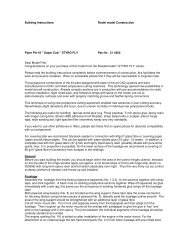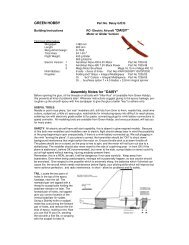Building instructions Pober Pixie - aero-naut Modellbau
Building instructions Pober Pixie - aero-naut Modellbau
Building instructions Pober Pixie - aero-naut Modellbau
Create successful ePaper yourself
Turn your PDF publications into a flip-book with our unique Google optimized e-Paper software.
<strong>Pober</strong> <strong>Pixie</strong><br />
Sand the internal surfaces of the GRP fuselage moulding with abrasive paper (150-grit to 180-grit) to<br />
provide a “key” for the adhesive before gluing any component to it.<br />
Trial-fit and trim all parts carefully before reaching for the glue bottle.<br />
Epoxy is heavy; when using this adhesive for glued joints take care to use the absolute minimum. It is<br />
sometimes advisable to thicken the resin with micro-balloons. Read the <strong>instructions</strong> supplied by the<br />
adhesive manufacturer.<br />
Avoid sharp corners and edges when cutting out the openings in the fuselage. Reinforce cut edges by<br />
gluing glass rovings or pieces of plywood on the inside.<br />
Save weight wherever possible, especially at the tail end (tailplane and fin).<br />
As an alternative to epoxy you can use PU (polyurethane) adhesive such as ISOLEMFI 3300 (made<br />
by EMFI) or Sikaflex 252 to glue components to the GRP parts. PU glues are very simple to use<br />
because they are thixotropic (do not run) and harden without problem. PU foaming adhesives can also<br />
be used.<br />
Before painting the fuselage it is essential to de-grease the surfaces and carefully rub down the joint<br />
lines using 400-grit wet-and-dry paper, used wet.<br />
Fuselage<br />
Wing strut supports<br />
• Prepare the openings for the laminated wing strut supports as shown in the fuselage drawing.<br />
A recess is moulded into the fuselage at the support location - drill through the fuselage at the<br />
support position and cut the opening to final size using a milling cutter or a file. Check that the<br />
openings are the same size and in the same position on both sides.<br />
• The laminated strut supports are supplied with accurate holes for clevis-type strut ends. All<br />
you need to do is clean up the edges and round off the ends.<br />
• Centre the strut supports relative to the fuselage centreline, and tack them in place lightly<br />
using cyano. They are eventually glued in place permanently using epoxy, but not until the<br />
undercarriage mounting has been installed.<br />
Tip: apply the cyano glue in the centre of the fuselage to avoid the adhesive running onto the outside<br />
surface of the fuselage and spoiling its appearance. If this should happen, wipe off the excess using<br />
cyano cleaner.<br />
Undercarriage<br />
Main undercarriage<br />
• The main undercarriage unit is made of dural and features pre-drilled mounting holes. Section A-A<br />
shows the method of attaching the undercarriage - it is held in place by two M5 screws fitted from<br />
the outside.<br />
• Trim the plywood undercarriage support #1 to fit snugly in the fuselage. Cut lightening holes in the<br />
support, but take care to avoid the area of the holes for the retaining nuts. Glue the plywood<br />
support in place.<br />
• Place the undercarriage unit on the fuselage, align it carefully relative to the fuselage centreline<br />
and drill the 5 mm Ø holes through the fuselage. Remove the undercarriage again.<br />
• Glue the reinforcing plates #3 (3 mm plywood, 15 x 15 mm) to the undercarriage support over the<br />
screw holes.<br />
• Allow the glue to harden, then drill 8 mm Ø holes in the plates and epoxy the plastic nuts in the<br />
holes.<br />
Tip: screw the undercarriage to the fuselage while the epoxy is still soft, so that the screws hold<br />
the plastic nuts in the correct position.<br />
• De-grease the undercarriage unit and sand the central area. Place the balsa block #10 on the<br />
undercarriage, mark the position of the holes and drill them. Note: the balsa block is tapered so<br />
that it fits accurately in the prepared channel; it will only fit one way round.<br />
• Enlarge the holes in the balsa in-fill piece so that the heads of the M5 retaining screws rest on the<br />
metal itself.<br />
• Glue the balsa block #10 to the central part of the cleaned and sanded undercarriage unit.<br />
• Place this assembly on the fuselage. Apply masking tape to the fuselage to prevent it picking up<br />
scratches, then sand the balsa block so that it follows the lines of the fuselage.<br />
Tip: apply sanding sealer and primer to the balsa parts before painting the model.<br />
<strong>Pober</strong> <strong>Pixie</strong> building <strong>instructions</strong><br />
3




